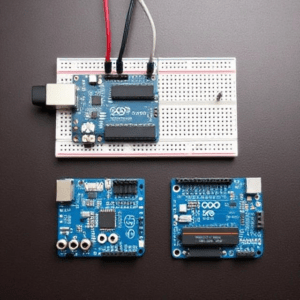1. Arduino Uno (most common)
- What it is: The Arduino Uno is the most popular and beginner-friendly Arduino board. It’s a small circuit board that can be programmed to control sensors, motors, lights, and other devices.
- Key Features:
- 14 digital pins
- 6 analog pins
- USB connection for programming
- Use cases: Perfect for basic projects, such as controlling LEDs, creating simple robots, or reading sensors.

2. Arduino Nano
- What it is: The Arduino Nano is a smaller, more compact version of the Uno. It has the same functionality, but it’s designed to fit into smaller spaces.
- Key Features:
- Same microcontroller as the Uno, but smaller and cheaper
- 22 digital pins, 8 analog pins
- Use cases: Great for projects with limited space, like wearable electronics, small robots, or when you need to embed it into a device.
3. Arduino Mega
- What it is: The Arduino Mega is a more powerful and larger board than the Uno. It has more pins and memory, making it suitable for complex projects.
- Key Features:
- 54 digital pins
- 16 analog pins
- 256 KB of memory
- Use cases: Ideal for advanced projects, like controlling large-scale robots, 3D printers, or handling many sensors and actuators at once.
4. Arduino Leonardo
- What it is: The Arduino Leonardo is a special version of the Arduino that can act like a computer device (like a mouse or keyboard) when connected to a PC.
- Key Features:
- Can emulate mouse or keyboard input
- 20 digital pins, 12 analog pins
- Use cases: Great for projects that need to simulate a mouse, keyboard, or game controller, like custom computer peripherals.
5. Arduino Due (for more advanced projects)
- What it is: The Arduino Due is a more powerful board, designed for complex, high-performance tasks. It uses a 32-bit processor, which is much faster than the 8-bit processor used in other Arduino boards.
- Key Features:
- 54 digital pins
- 12 analog inputs
- 84 MHz processor (faster than others)
- Use cases: Perfect for advanced projects that require fast data processing, like advanced robotics, audio processing, or complex sensor systems.
Tags: 12 analog pins, 16 analog pins, 20 digital pins, 256 KB memory, 32-bit processor, 3D printers, 54 digital pins, 84 MHz processor, Actuators, advanced projects, advanced robotics, analog pins, Arduino, Arduino boards, Arduino boards comparison, Arduino Due, Arduino Leonardo, Arduino Mega, Arduino Nano, Arduino Uno, audio processing, beginner-friendly, compact board, complex sensor systems, cost-effective, custom peripherals, Development Board, digital pins, Embedded Systems, fast data processing, game controller, HID (Human Interface Device), high memory, high-performance board, keyboard emulation, large-scale robots, LEDs, Microcontroller, microcontroller platform, motors, mouse emulation, multiple sensors, open-source hardware, programmable electronics., prototyping, Sensors, simple robots, small form factor, space-saving, USB programming, wearable electronics


